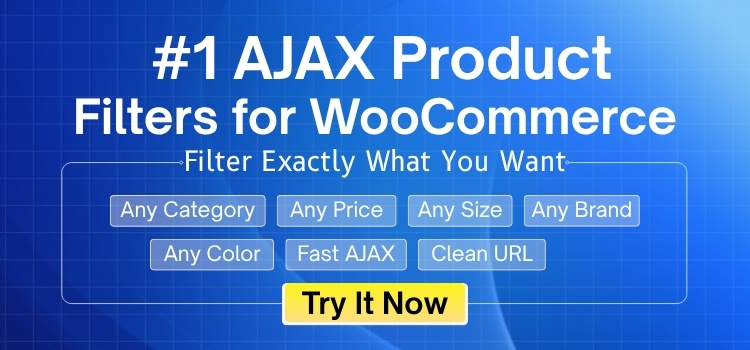Multilingual stores are growing fast because people want to shop in their own language. If you’re using WooCommerce, you might be thinking about adding product filters too. Filters help shoppers find what they need quickly. At this point, you might be wondering something important: Can WooCommerce filters work with multilingual stores?
WooCommerce filters can work with multilingual stores when set up properly. You need a multilingual plugin like WPML, TranslatePress, or Polylang. These plugins help you translate product details, filters, and attributes. They also keep everything in sync across languages. Once done, your filters will show the correct options in each language and work without any errors.
Do you want to make sure your filters show the right options in every language? Keep reading, because this article shares all the key details you need to know to get it working right.
Can WooCommerce Filters Work With Multilingual Stores?
Yes, WooCommerce filters can work with multilingual stores. Setting them up the right way helps shoppers find products easily, no matter what language they are browsing in. Want to know how to make this possible? Check below to learn how to make WooCommerce filters work with multilingual stores.
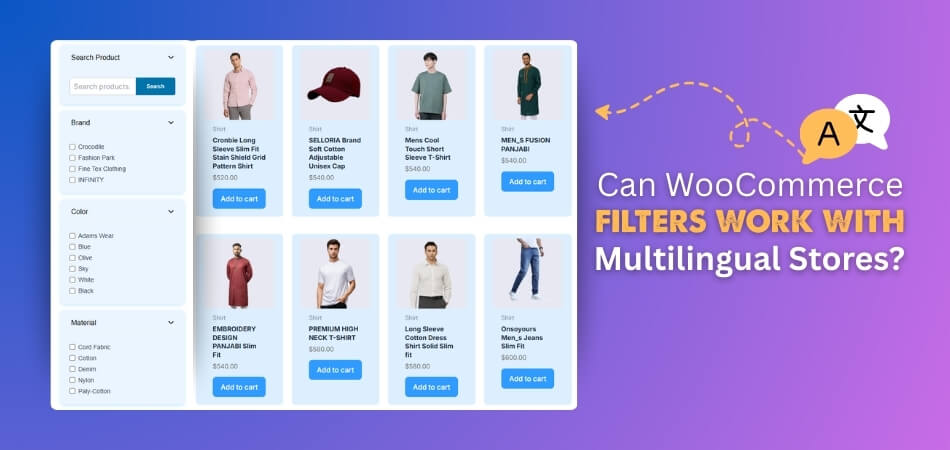
Choose a Plugin
The first step is to pick a good multilingual plugin that works well with WooCommerce. Some popular choices are WPML, TranslatePress, and Polylang. Each of these plugins helps you manage translations for your store. Make sure the plugin you choose supports product filters so they work correctly in every language.
Translate Filter Text
Filters often show labels like color, size, or category. These words need to be translated so shoppers understand them in their own language. A multilingual plugin lets you translate headings and filter labels easily. Once done, all filter options will look clear and meaningful in every language version of your store.
Translate Products
It is important to translate the actual product data too. This includes product names, descriptions, and details like materials or features. A multilingual plugin helps keep this data consistent across languages. This way, customers browsing in any language get the same product details without confusion.
Synchronize Attributes
Some product attributes, like sizes or weights, do not change with language. These should be synced so that they remain the same across all translations. On the other hand, attributes like colors or patterns need proper translation. Synchronization ensures that both text and non-text attributes are always accurate.
Test Functionality
After setting everything up, you should test the filters on your store’s front end. Check how products appear when filters are applied in each language. Make sure the right products show up and all labels look correct. This step helps you confirm that everything works smoothly for users in different languages.
Customized Manually
Sometimes, automatic translations may not give the best results for filters. In such cases, you can customize them manually using the WooCommerce Ajax product filter plugin settings. This allows you to make changes in specific filter names or options to match local terms better. Manual customization gives you full control to make filters more user-friendly and accurate.
Why Does Multilingual Support Matter for WooCommerce Stores?
Multilingual support can change how a WooCommerce store connects with people worldwide. It makes the store easier to use for shoppers who prefer different languages. At the same time, it helps businesses grow faster and reach more customers. If you want to see why this really matters, read below.
Better Accessibility
Making a store available in many languages allows more people to use it without struggling. Shoppers can browse products, read details, and place orders in the language they understand best. Online shopping becomes smoother and less confusing. Accessibility like this ensures that no customer feels left out.
Global Reach
A multilingual store helps you reach buyers in different countries. Instead of limiting your store to one region, you can connect with customers across the world. This increases sales opportunities and helps your brand become recognizable in more markets. It makes your store truly global.
SEO Benefits
Search engines treat each language version of your store as unique content. This means your store has a chance to rank for keywords in multiple languages. By doing this, you can attract more visitors from different regions. Good SEO in many languages brings in steady organic traffic.
Customer Trust
Shoppers are more likely to trust a store that speaks their language. It shows that the store cares about their comfort and understanding. Clear product details in local languages reduce doubts and improve trust. A trusted store always gets more repeat buyers.
Improved Sales
When customers feel comfortable browsing in their language, they are more likely to buy. They understand product descriptions better and feel confident about their choices. This reduces abandoned carts and increases successful checkouts. In the end, sales grow naturally with language support.
Competitive Edge
Not all stores offer multilingual options, so adding this feature makes your store stand out. Customers often choose the store that is easiest for them to use. A multilingual WooCommerce store gives you a clear advantage over competitors. It positions your brand as customer-friendly and forward-looking.
Challenges of Running a Multilingual WooCommerce Store
Running a multilingual WooCommerce store may sound simple at first, but it often brings some hidden difficulties. These challenges can affect how smooth the store feels for both owners and shoppers. To understand them better, here are some details about it:
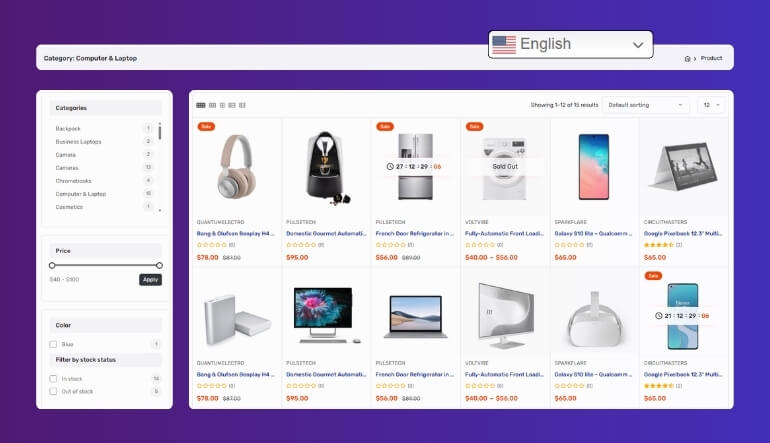
Translation Consistency
One of the biggest challenges is keeping translations consistent across all pages. If product names or filter labels are translated differently in multiple places, customers can get confused. This inconsistency may also affect search results inside the store. Using the same terms everywhere is important for a professional and clear shopping experience.
Product Descriptions
Translating product descriptions is not always easy. Some words may not have the same meaning in another language. This can make descriptions unclear or even misleading to customers. Careful translation ensures that product details remain accurate and easy to understand.
URL Structures
Multilingual stores often face problems with URLs. Each language version of a page may need its own clean and readable link. If not handled properly, it can confuse search engines and users alike. Setting correct URL structures helps with both SEO and user trust.
Duplicate Products
Sometimes, product pages may appear as duplicates when they exist in multiple languages. Search engines may see this as repeated content and rank it lower. Store owners need to manage duplicates carefully to avoid SEO penalties. Tools within plugins often help reduce this issue.
Filter Issues
Filters may not always work well with different translations. A customer selecting a size or color in one language may not see the same product in another version. This can create frustration and reduce sales. Understanding the possible causes of filter not working in WooCommerce helps you fix these issues before they affect the shopping experience. Testing filters in each language is very important to make sure they work correctly.
User Experience
Customers expect the same level of comfort no matter which language they choose. If one version looks incomplete or harder to use, shoppers might leave. Balancing layouts, navigation, and translations across all languages keeps the experience smooth. A good user experience encourages people to shop more.
Technical Setup
The technical part of running multiple languages can be tricky. Syncing product data, attributes, and inventory across languages often takes extra work. Without proper setup, stores may show errors or outdated information. A reliable multilingual plugin is the key to solving most of these problems.
Filter Plugin That Works Well With Multilingual Stores
Filter plugins play a big role in helping shoppers find the right products faster in an online store. When your store runs in more than one language, choosing the right filter plugin becomes even more important. If you want to know which plugins work best, keep reading below.
Dynamic AJAX Product Filters for WooCommerce
Dynamic AJAX Product Filters is a popular choice for multilingual WooCommerce stores. It updates results instantly without reloading the page, keeping the shopping process fast and smooth. The plugin works well with translation tools, ensuring filters stay accurate across languages. Store owners can also customize filters like price, category, and attributes easily.
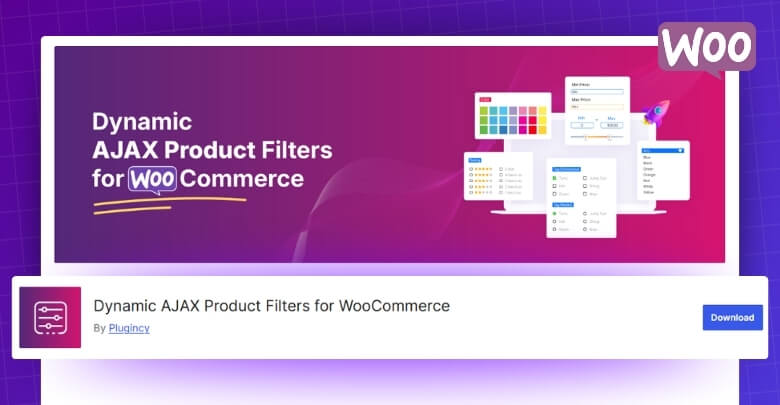
WOOF (WooCommerce Products Filter)
WOOF provides strong filtering features and works well with translation tools like WPML when set up correctly. Shoppers can filter by categories, tags, attributes, and even custom fields. It ensures filter labels stay accurate across different languages. WOOF gives your store powerful and clear filters.
Premmerce Product Filter
Premmerce Product Filter is another great choice for multilingual WooCommerce stores. It offers advanced filter options and integrated translation support. Shoppers can use filters easily, and store owners can style them cleanly. It keeps filtering clearly and easily across all language versions.
Barn2 WooCommerce Filter
The WooCommerce Product Filter by Barn2 Plugins works well with translation tools like WPML, WeGlot, and TranslatePress. It offers advanced filtering logic, and shoppers see only filters that apply to the current products. This plugin is easy to set up and gives a smooth, multilingual experience.
Search & Filter Pro
Search & Filter Pro also supports multi-language use and works with the WooCommerce Multilingual Plugin. It lets you build advanced search options by categories, tags, attributes, and more. This works cleanly with translation tools, so filters stay accurate and helpful in every language.
How to Test Filters Across Multiple Languages?
Testing filters in a multilingual WooCommerce store is an important step to make sure everything works smoothly for customers. It helps confirm that products, pages, and filter results show correctly in every language. To properly check this, take the actions listed below.
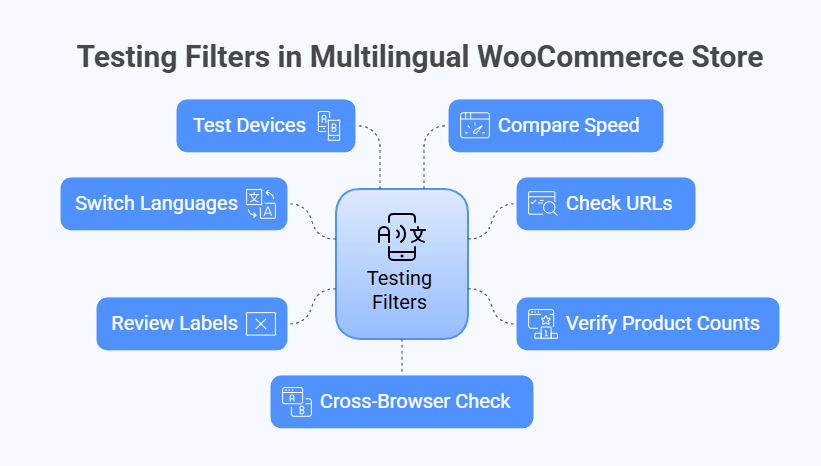
Switch Languages
The first thing is to switch between all the languages on your store. Make sure filters like size, color, or brand change properly with the language. Customers should see the same filter options, but in the correct language. This check ensures filters are translated well.
Check URLs
Each language should create clean and clear URLs for filtered results. When switching filters in another language, the URL should reflect the choice correctly. Bad or duplicate URLs can confuse both users and search engines. Checking URLs helps keep the site professional and SEO-friendly.
Verify Product Counts
Apply filters in each language and see if the product counts match. For example, if “Blue Shirt” shows 10 items in English, it should also show 10 in Spanish or French. Wrong product counts may confuse shoppers and lower trust. This check makes filters more reliable.
Review Labels
Filter labels like “Color” or “Category” should appear properly in all languages. Sometimes translations can look broken or incomplete. Check that every filter label is correct and easy to understand. Clear labels make it easier for customers to use filters.
Test Devices
Filters should work smoothly, not just on desktops but also on mobiles and tablets. Switch languages and apply filters on different devices. Make sure layouts, dropdowns, and buttons look neat everywhere. This step ensures that every shopper has the same easy experience.
Compare Speed
Filters should load products quickly in every language. Slow results can make customers leave. Check that AJAX-based filters or instant updates are working correctly in different languages. Testing speed gives a clear idea of overall performance.
Cross-Browser Check
Customers may use browsers like Chrome, Safari, or Firefox. Switch languages and test filters across these browsers. Sometimes, design or functions break in one browser but not in others. Along with browser testing, checking WooCommerce filters on mobile devices ensures the same smooth performance for every shopper.
Frequently asked questions
When setting up filters in a multilingual WooCommerce store, many store owners still have extra questions. These questions usually come up when they want to make sure filters run smoothly in every language. Below you’ll find answers to the most common ones.
How Do Filters Handle Currency Differences?
Filters only manage product details like size, color, or category, but when you pair them with multilingual plugins, they can show correct currencies as well. Some plugins integrate with currency switchers, ensuring filters and prices match the shopper’s language and region.
Can Filters Work With RTL Languages?
Yes, filters can be styled to support right-to-left languages like Arabic or Hebrew. Most multilingual plugins and modern WooCommerce themes support RTL layouts. Filters adjust automatically, but it’s always smart to test them for proper alignment and readability.
Do Filters Affect Site Speed in Multilingual Stores?
Filters can slow down your site if not optimized, especially when running across multiple languages. Using AJAX-based filters helps reduce page reloads. A well-coded filter plugin combined with good hosting ensures smooth performance even with several languages active.
How Do Filters Handle Seasonal Products?
Filters can include seasonal attributes like “Summer Collection” or “Winter Sale.” When translated, they remain clear in every language. This makes it easy for global shoppers to browse seasonal items and ensures they understand product relevance, no matter their language.
Can Filters Be Linked With Search Bars?
Yes, filters often work alongside search bars. Shoppers can search and then narrow results with filters. In multilingual stores, the search results and filters both switch to the chosen language, keeping the shopping flow consistent and easy to use.
Do Filters Need a Separate SEO Setup?
Filters don’t directly need SEO optimization, but the URLs they create do. Clean and language-specific filter URLs help search engines understand your store. A good plugin ensures these URLs are translated properly and do not harm SEO rankings.
How Do Filters Work With Out-of-stock Products?
Filters can be set to hide or show out-of-stock products. In multilingual stores, this function remains the same. Shoppers in any language will only see products available for purchase, improving trust and saving them time.
Bottom Line
Finding the right balance between languages and filters can feel challenging, but when it works, it changes how customers shop in your store. A smooth multilingual filter system makes shopping faster, clearer, and much more enjoyable for everyone.
So, can WooCommerce Filters Work with Multilingual Stores? The answer is yes. With the right plugins, careful translation, and proper testing, your store can deliver accurate filters in every language. This creates a shopping experience that feels natural and trustworthy.
If you’re aiming to grow your store globally, adding multilingual support to filters is a smart step. It helps your store stand out, keeps customers happy, and makes shopping easier. Start small, test carefully, and watch your store reach more people.
